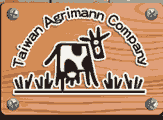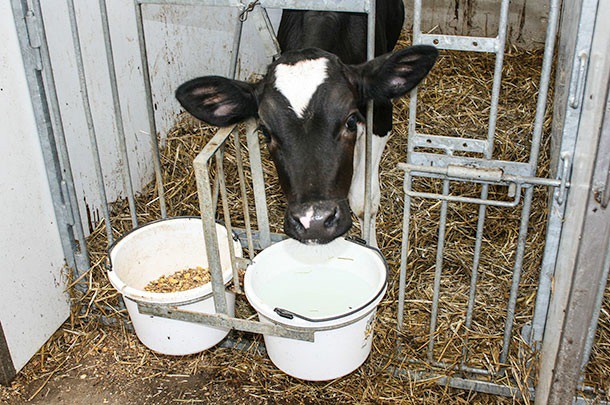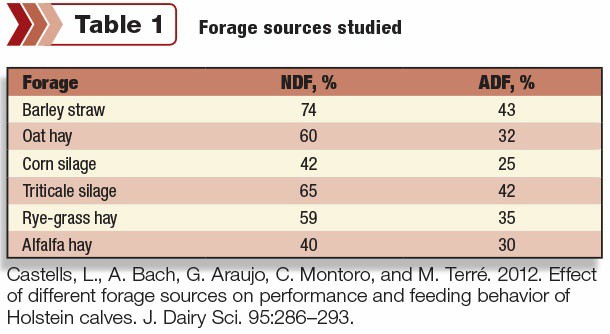



仔牛也需要吃乾草嗎?
Feeding forage to calves: Is it necessary?
反芻動物的消化道在出生後面臨重要的變化,在出生過程中,仔牛瘤胃中會開始擁有一小群微生物。
瘤胃生理發育的程度是透過瘤胃微生物的生長狀況來評估,且瘤胃微生物的生長狀況可以代表動物將植物轉換成維持及生產的能力。
出生時,仔牛的瘤胃佔了胃部總體積的35%,在離乳時成長至胃部總體積的65%。然而,這些轉變必需要消耗適量且適當型式的固體食物,當仔牛開始採食固體飼糧(尤其是澱粉類穀物)時,微生物利用這些成分做為基質,以維持自生的生長及生產揮發性脂肪酸(VFA)。這些VFA,尤其是丁酸,會促使瘤胃中專門吸收VFA的絨毛生長。
隨著VFA在瘤胃中堆積,瘤胃液中pH值下降,且瘤胃pH值會影響瘤胃菌相。事實上,瘤胃中澱粉分解菌、丁酸菌、纖維分解菌及甲烷菌,隨仔牛年齡增加而呈線性增加。相反的,乳酸利用菌及大腸菌群在出生後第一周快速減少。
瘤胃發育是確保仔牛可以成功離乳的關鍵,僅給予牛奶對於仔牛來說無法刺激瘤胃絨毛的生長,而固體飼糧,會促使瘤胃VFA含量增加,可以加速瘤胃發育。澱粉分解菌藉由發酵澱粉產生的丁酸,是刺激瘤胃絨毛發育最重要的VFA,這也是仔牛教槽料以澱粉類穀物做基礎的主要原因。此外,牧草是纖維分解菌發酵所必需的原料,主要會產生乙酸,而乙酸對於瘤胃發展的影響非常的小。
雖然澱粉是教槽料中最重要的原料,但是對於瘤胃微生物的分化有負面的效果,並且會降低瘤胃pH值並導致瘤胃過酸的狀況。瘤胃過酸會使瘤胃絨毛的角質層過度堆積,降低VFA的吸收率。雖然透過限制澱粉含量的方式,可以避免瘤胃過酸的狀況,但這並不是最好的處理方式。事實上,仔牛需要澱粉並不只是為了瘤胃的發育,並且也提供了生長所需的能量。因此,重要的是如何給予高澱粉含量的飼糧並且避免瘤胃過酸的風險,以下有兩個建議:
1. 餵飼高品質的組織化飼糧(texturized feed)。
2. 餵飼草料搭配打粒飼糧。
但是,再次重申,並非任何草料或組織化飼糧可以解決這個問題。
給予組織化飼糧(texturized feed)
相較於少量多餐,通常餵飼仔牛教槽料是以多量少餐的方式進行。如果飼糧中的澱粉可以快速發酵產生VFA,則多量少餐的餵飼方會使VFA的產生量大於瘤胃的可吸收量,當多餘的VFA累積在瘤胃中,pH值降低,創造一個適合乳酸生產菌生長的環境,並且再度降低瘤胃pH值,可能造成瘤胃酸中毒的狀況。當仔牛餵飼含有一半或更多全粒穀物及蛋白質的粒狀組織化飼糧,全粒穀物中所含的澱粉只有在咀嚼時或反芻時才會釋放並且被微生物發酵利用,此時,瘤胃中的澱粉屬於慢速發酵。如果飼糧中的穀物是經過粉碎的或是粉碎後打粒,此時,瘤胃中的澱粉屬於快速發酵,容易導致瘤胃酸中毒。
餵飼乾草搭配打粒教槽料
如果要製造高品質的打粒飼糧,穀物必須先經過粉碎的步驟,穀物內含的澱粉顆粒經過破碎後,使得表面積增加,瘤胃微生物可以接觸進行發酵的表面積也會增加,打粒時的溫度會使的澱粉產生明膠化的作用,使得澱粉的發酵利用率提升,因此,餵飼打粒的高澱粉含量飼糧會提高酸中毒的風險。另外,由於粗料在瘤胃中產生的物理研磨功能可以避免瘤胃絨毛的角質化。基於以上兩個原因,仔牛餵飼打粒教槽料時,必須額外添加乾草,然而,草料品質、片段長短及量都是必須考慮的重點。
一篇西班牙的研究,評估餵飼不同乾草來源(片段長度1英吋)對出生到離乳後兩周仔牛的影響(表1)。仔牛餵飼乾草(除了苜蓿乾草)與沒有乾草的仔牛相比較,濃縮料的採食量及生長性狀都有比較好的表現。值得注意的是,給予乾草的仔牛對於乾草的採食量都低於總固體飼糧的10%。相反的,給予仔牛苜蓿乾草,仔牛對於乾草的採食量佔總固體飼糧採食量的14%,對於教槽料的採食量有負面的影響。有一些研究的數據指出當乾草的採食量佔總固體飼糧的5%以下時,會有較適當的生長表現,而乾草採食量多於10%時,生長表現會受到抑制。
表1 乾草來源的研究
乾草種類 |
NDF, % |
ADF, % |
麥稈 |
74 |
43 |
燕麥乾草 |
60 |
32 |
玉米青貯 |
42 |
25 |
黑麥青貯 |
65 |
42 |
黑麥乾草 |
59 |
35 |
苜蓿乾草 |
40 |
30 |
當乾草採食量超過總固體飼糧採食量的10%時,可能會導致乾草堆積在消化道中。當攝取高比例乾草時,乾草堆積在腸道中會導致仔牛發生"乾草肚(hay bellies)"的狀況,在這個狀況下的體增重是由於腸道中有乾草堆積,而不是屠體增重。然而當乾草採食量小於總採食量的5%且乾草被切短至適當長度時,乾草就不會是腸道堆積的主因。
仔牛需要乾草當教槽料,是為了避免仔牛暴露在瘤胃酸中毒的狀況中,或避免因教槽料沒有提供適當的物理研磨功能,致使絨毛角質層堆積的狀況發生,而乾草的品質、數量及片段長度也是很重要的考量因素,因為這些因素會影響給飼乾草的效果。在保育期間,仔牛採食適當片段長度的低品質乾草(高NDF)且乾草採食量佔總固體飼糧採食量的5%以下時,生長表現較好;此外,如果提供含有50%以上全粒穀物的高品質組織化教槽料,可以提供瘤胃適當的物理研磨功能,則此時也可以選擇不提供乾草。
資料來源:
www.progressivedairy.com/topics/calves-heifers/feeding-forage-to-calves-is-it-necessary
![]()
Feeding forage to calves: Is it necessary?
www.progressivedairy.com
/topics/calves-heifers/feeding-forage-to-calves-is-it-necessary
After birth, the gastrointestinal tract of ruminants undergoes important anatomical changes. At birth, calves possess a very small microbial population in the rumen.
Establishment of rumen microbiota is necessary for the physiological development of the rumen and for the animal’s ability to convert plant mass into products that can be utilized by the animal for maintenance and production.
At birth, the rumen represents about 35 percent of the total stomach compartments, and it increases to approximately 65 percent by weaning. However, for these changes to take place, calves need to consume adequate amounts and types of solid feed. When calves start to consume dry feeds (especially starchy grains), bacteria use these compounds as substrates to sustain their growth and produce volatile fatty acids (VFA). The presence of these VFA, especially butyrate, will stimulate rumen papillae growth. Papillae are responsible for VFA absorption.
As VFA accumulate in the rumen, the pH of the rumen liquid declines, and the rumen pH may affect rumen microbial population. In fact, the content of rumen amylolytic, proteolytic, cellulolytic and methanogenic bacteria increases linearly with age in the young calf. In contrast, the proportion of lactate-utilizing and coliform bacteria gradually declines during the first weeks of life.
Rumen development is a key factor to ensure successful weaning of calves. Feeding only milk to calves does not stimulate papillae development, but the consumption of solid feed and the resulting increase in rumen VFA concentrations stimulate rumen morphological development. Butyrate is the main stimulatory VFA for rumen papillae development. Butyrate is produced by amylolytic bacteria, which ferment starch, and this is the main reason why grain-based starter feeds are often recommended for the milk-fed calf. On the other hand, forage is fermented by cellulolytic bacteria, which produce mainly acetate, which has little to no effect on rumen development.
Even though starch may be the most important ingredient in starters, it could negatively impact rumen microbial diversity and lower rumen pH to acidotic conditions. Rumen acidosis increases the keratin layer of papillae, which reduces the capacity for VFA absorption. Although it may seem logical to limit starch content to avoid acidosis, that is not the answer. The calf actually needs that starch not only for rumen development, but also to provide the energy needed to sustain growth. The trick lies in learning how to feed high amounts of starch without putting calves at risk for acidosis. There are two approaches:
1. Feed a high-quality texturized starter.
2. Feed forage along with a complete pellet starter.
But again, not any forage will do the trick and neither will every texturized starter.
Feeding a texturized starter
Rather than eating several small starter meals over the day, calves often eat large amounts of starter in a few meals. If the starch in the dry feed is rapidly fermented to VFA, it could surpass the capacity for VFA adsorption. As VFA accumulate in the rumen, pH decreases, creating the environment for lactic acid producing bacteria to thrive and further decrease rumen pH, possibly reaching acidotic condition. When calves are fed a textured starter with half or more whole grains and a protein pellet, the starch in the whole grains will only be available for fermentation once the grain has been chewed either while eating or during rumination. Thus, starch fermentation to the rumen is slow. If
the grains are ground and fed, or ground, pelleted and fed, the starch fermentation in the rumen is fast and the rumen can be subject to acidosis.
Feeding forages along with pelleted starter
For the manufacturing of a good quality pellet, grains need to be finely ground, which increases the surface area for rumen bacteria to ferment starch. Pelleting temperature further increases starch fermentability by gelatinizing the starch. Thus, feeding a complete pellet high in starch increases the risk for acidosis. For this reason and because pellets do not provide the necessary abrasiveness for preventing the buildup of keratin on rumen papillae, calves fed complete pellet starter should be supplemented with forage. However, the forage quality, particle size and quantity are important to consider.
A Spanish study evaluated the effects of feeding different forage sources (all chopped at 1 inch) to young calves from birth to two weeks after weaning (see Table 1). Calves fed forage (with the exception of alfalfa hay) consumed more concentrate and grew more compared with the non-forage supplemented calves. It is important to highlight that calves fed grass forages voluntarily consumed less than 10 percent of their dry feed diet as forage. In contrast,
calves fed alfalfa hay consumed 14 percent of forage from the total solid feeds consumed, which negatively affected starter intake. Data from several studies indicate that when forage represents less than 5 percent of the total solid feed consumption, calf growth is optimized, and when forage represents more than 10 percent of total dry feed consumption, growth is reduced.

When the consumption of forage represents more than 10 percent of total solid feed intake, it can also result in the accumulation of forage in the gastrointestinal tract. When even higher proportions of forage are consumed, forage accumulation in the gut can result in calves with “hay bellies.” Body weight gain in those situations is due to gut fill, rather than carcass weight gain. However, when consumption of forage is less than 5 percent of solid feed intake and forage is chopped, forage will not play a big role in gut fill.
Calves need forage when the starter they are fed puts them at risk for rumen acidosis or when the starter does not provide sufficient abrasiveness to prevent the buildup of the keratin layer. Forage quality, quantity and particle size are important to consider because these aspects will impact the results of feeding forage. In the nursery period, calves do better when they have access to a forage of low quality (high NDF) and is finely chopped so that forage consumption is less than 5 percent of total solid feed intake. Forage may not be needed in the nursery period when calves are fed a high-quality texturized starter with at least 50 percent whole grains, which provide abrasiveness for the rumen. PD
Xavier Suarez is a calf and heifer nutritionist for Provimi North America. Email Xavier Suarez.
Alex Bach is the department head of the department of ruminant production at the Institute for Research and
Technology in Agrifood (IRTA) in Barcelona, Spain. Email Alex Bach.
PHOTO: Staff photo.
